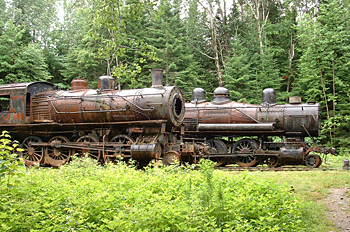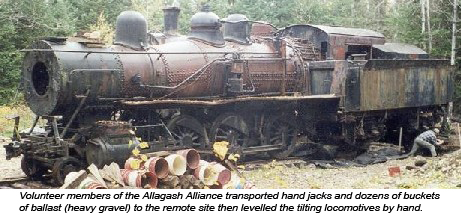DACF Home → Bureaus & Programs → Bureau of Parks and Lands → Discover History & Explore Nature → History & Historic Sites → The Eagle Lake & West Branch Railroad
The Eagle Lake & West Branch Railroad
 There are not a lot of places
in the world where you can be hiking through a remote wilderness
and suddenly stumble upon rusting locomotives. One of the
things that makes the Allagash so fascinating is the possibility
of a sudden discovery of remnants from a bygone lumbering
industry. For example, you could be walking through the wild
forests of northern Maine after landing your canoe on the shore of Eagle Lake and then suddenly you're staring
down the nose of two steam locomotives.
There are not a lot of places
in the world where you can be hiking through a remote wilderness
and suddenly stumble upon rusting locomotives. One of the
things that makes the Allagash so fascinating is the possibility
of a sudden discovery of remnants from a bygone lumbering
industry. For example, you could be walking through the wild
forests of northern Maine after landing your canoe on the shore of Eagle Lake and then suddenly you're staring
down the nose of two steam locomotives.
For those lumbering operations still driving logs south from Eagle and Churchill Lakes to Penobscot waters, the Eagle Lake and West Branch Railroad replaced the Tramway. In 1926 this railroad ran from the Eagle Lake end of the tramway thirteen miles to Umbazooksus Lake, which connects to the West Branch of the Penobscot River via Chesuncook Lake. Edouard “King” Lacroix’s Madawaska Company purchased a ninety-ton steam locomotive in New York and converted it from coal to oil burning for this operation. To haul the large supply of oil needed for the train, the company leased a Plymouth gasoline engine from Great Northern Paper. The oil was brought in barrels by truck from Greenville to Chesuncook Dam. From there, a scow would carry the barrels to the terminal end of the railroad on Umbazooksus Lake.
During the
winter of 1926-27, Lombard tractors hauled all of the materials
for the railroad from Lac Frontiere to Churchill Depot, then
across Churchill Lake to the shore of Eagle Lake. This included
the fifteen hundred foot trestle for Allagash Stream, steel
rails, loaders, two gas-powered switchers, sixty train cars,
and the two one hundred ton locomotives. King Lacroix, however,
never got the railroad into operation because the Great Northern
Paper Company bought his operation early in 1927. On June
1, 1927, the railroad made its first successful trip as the
Eagle Lake and West Branch Railroad.
To
load the train cars on the Eagle Lake end of the line, logs
were drawn along two conveyors that raised them up twenty-five
feet over a two hundred twenty-five foot length. With a forty-horse
power diesel engine powering each conveyor, a cord of wood
could move from lake to car in just ninety seconds. Each twelve-cord
car could be filled in eighteen minutes. Operators soon discovered
that the time it took to neatly pile the logs into the cars
horizontally made the practice inefficient, so they resorted
to just dumping them in as they fell from the conveyors. The
cars were built with a twelve-inch tilt in them so that when
they drove out onto the unloading trestle at the Umbazooksus
end (where the tracks were tilted six more inches) an operator
could knock loose the pins holding back the car wall hinged
at the top and most of the load would tumble out into the
water. A little picking and prodding of the remaining logs
and the train was on its way back for another load.
Since the round trip over
the curvy road made a single-train operation too slow and
inefficient, the company used two trains of ten cars each,
with a passing track in the middle so the empty car on its
return route could pass the full car headed in the other direction.
The trains of twelve cars each ran on the road both day and
night stopping only ten minutes to service the steam engine.
While this happened, the Plymouth engine pushed a set of loaded
cars away from the conveyors where the locomotive could hook
up to it. The Plymouth then took the empty cars, just back
from their run, and pushed them under the conveyors for loading.
This system, along with the addition of an electric lighting
system for loading the cars and storage towers to allow faster
refilling of the trains’ water and oil, increased the
log-hauling capacity four hundred percent. In an average week,
more than six thousand five hundred cords of wood moved across
the tracks.
The Plymouth engines at each
end of the train route shifted empty cars around the yard
while the locomotives refueled. Logs could not float away
when too much bark gathered near the unloading trestle, so
engineers designed a special scraper that was attached to
the Plymouth by means of a pulley and anchor and this system
scraped the bark out of the way.
The railroad crossed over the northwest arm of Chamberlain Lake where it reaches toward Allagash Lake.
The most significant structure of this operation was the fifteen hundred foot long railroad trestle sturdy enough to carry both the train and its regular supply of heavy log cargo across this piece of water. Only a few remains of the trestle are still visible.
Aerial photographs from 1966 show that only one structure, the shed built over the locomotives, remained at the railroad site on the Eagle Lake end of the tramway when the Allagash Wilderness Waterway was created. While still owned by the Seven Islands Land Company on April 9, 1969, the Maine Forest Service mistakenly burned the shed, causing damage to some of the wooden elements of the locomotives (i.e. the wooden cab). Both locomotives have also suffered from vandalism and souvenir hunters. Photos show the burned area on June 11, 1969.
On August 16, 1969, the Maine Parks and Recreation Commission painted the trains to prevent further rusting. In 1995, the boiler jackets on both locomotives were removed in order for asbestos surrounding the boilers to be removed and abated.
Members of the Allagash Alliance worked to right and stabilize Eagle Lake and West Branch Railroad Locomotive Number 1 and its Tender. Built in June 1897 at Schenectady Locomotive Works (4-6-0 stamped #4552), it was originally a steam locomotive that burned coal but later converted to burn oil to eliminate the forest fire threat caused by cinders. Number 1 was purchased by Great Northern in 1926 and used to haul pulpwood in the Allagash area from 1927-1933.
ELWB Locomotive Number 2, and its tender, were built in December 1901 at Brooks Locomotive Works (2-8-0 stamped 4062). Number 2 was also used as a coal-burning steam locomotive and later converted to burn oil. It was purchased by Great Northern in 1928 and used as the main engine for hauling pulp cars from 1928-1933. When the railroad stopped operating, both locomotives were relatively obsolete and not worth the cost of transporting them back out of the Allagash area. Instead, they were stored inside a shed at the Eagle Lake facility where they remain today.

Bibliography:
- Blodgett, Emerson F., “The Pulp Wood Express.” The Northern Logger, November, 1927. (BPL)
- MacGregor, Roy A., “Another Advance Step in Woods Transportation” The Northern, November 1926, pp. 3-9. (BPL)
- Shaughnessy, Jim, “Ghost Train in the Maine Woods.” Northern Pp. 40-79. (BPL)
- Shaughnessy, Jim, “Mystery in Maine: The Story of a Lost Railway.” Canadian Rail, No. 196, February 1967. (BPL)